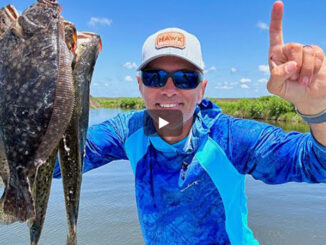
These strikes are even more fun when they reward kayak fishermen
On top or just below the surface, the time is now for some explosive summertime inshore action. I am truly amazed at the amount of kayak anglers I talk to, only to find out that they don’t or rarely fish topwater lures. While primetime for topwater action is generally the warmer months, they can also be effectively used year-round.
The trout spawn continues for the next two months and big female trout at their spawning peak get extremely aggressive with topwater baits. Topwater explosions from a kayak are second to none. Up close and personal, a topwater strike is sure to send your heart racing.
Successful topwater fishing is aided by the stealth and quietness of a kayak. You can get close to the action without spooking a bait school or the fish that are stalking them. Later in the summer, the trout have moved more to the outer edges of the marsh or near passes and islands for saltier waters. The key to locating fish is finding the bait. Schools of mullet or pogies flitting near the surface or shrimp popping are sure signs that fish are nearby.
Locate the bait
Once you locate the bait, slowly move the kayak close to the action staying just on the outer edges where you can cast to the bait. Anchoring is futile. The bait is moving, so take the time to watch and judge which direction they are traveling. Follow along, but don’t get too close.
Cast along the edges of the bait and not right in the middle. The goal is to have your lure singled out from the throngs of bait without spooking them. For topwater plugs, a walk-the-dog retrieve is hard to beat. If a fish strikes your lure, resist the urge to set the hook immediately. Pause briefly until you feel the fish on your line. This is easier said than done, but after a few missed fish, you will get the hang of it.
Missed strikes are common. Though seemingly impossible, somehow they strike and miss getting snagged by the multiple trebled hooks on most topwater lures. When this happens, there are two choices. One is to do nothing and let the bait sit, hoping that it returns for another strike. The other choice is to immediately speed up the retrieve hoping to cause a reaction strike as the fish thinks the bait is attempting to flee. Either can be productive depending on the mood of the individual fish.
When fishing topwater lures, always have a second rod rigged with a suspending lure. If the fish are blowing up on the topwater plug, but miss getting hooked, immediately make a cast to the same spot with the suspending lure. Very often, this results in a strike when the lure sinks a bit below the surface. Suspending lures also work well casting into the bait schools.
Use a wake bait
A third, lesser used, but highly productive option is a wake bait. These hard plastic baits have a downward facing lip that causes the floating lure to run on top of the water with a tight wiggle on retrieve. Internal metal BB’s add a rattling noise that helps draw explosive surface strikes. A simple cast and retrieve, with various speeds is all that is necessary to provoke vicious bites.
Fishing these lures is great for kayak fishing where room for tackle storage can be limited. A small box with a handful of each in various sizes and colors can be all you need for a productive day. For topwater and wake lures, color selection should be geared more for the lures bottom and lower side color as this is what the fish sees looking up to the lure. They cannot see the back. Suspending baits offer the opportunity for the lure to be seen from any direction, therefore the entire lure color/pattern comes into play.

Use caution
All three of these lure styles sport multiple treble hooks and kayak anglers should exercise caution when landing and unhooking fish. The close quarters of a kayak increase the odds of getting a hook in your own body (speaking from experience). A landing net with a rubber bag helps get control of the fish and makes getting it unhooked easier and safer. A fish contained in the net is much safer than flailing around in the kayak. A Boga Grip or other lip-grip tool helps control the fish during the de-hooking process.
Braid or mono lines work well with these styles of lures, but if braid is used, a length of mono or fluorocarbon leader should be added. A simple uni-to-uni knot works well. This provides a bit of stretch to act as a shock absorber to keep from ripping the hooks out of the fish’s mouth — especially trout.
Many species readily hit these hard plugs. A red trying to crash a topwater or wakebait usually pushes the bait away with the wake from its broad head. This can cause several misses in a row. It is super exciting and can produce some of the best topwater strikes ever. Other species are also regularly caught. Although I’ve never caught a sheepshead or drum on a topwater, catching them on a suspending plug or wake bait happens every now and then.
Any area you regularly fish in your kayak can be great for topwater, wakebaits or suspending lures. Gather a small selection and hit your favorite spots. All three of these lure types work well year-round and are highly effective.


